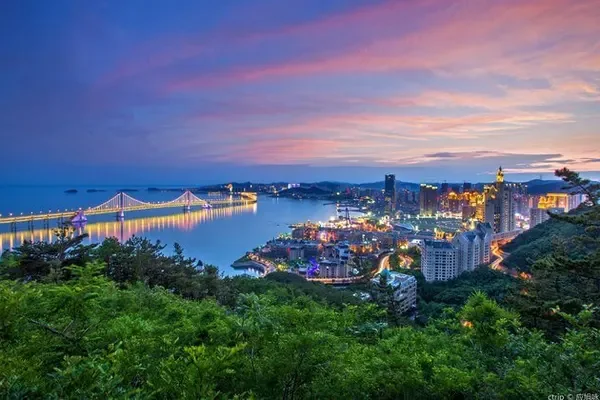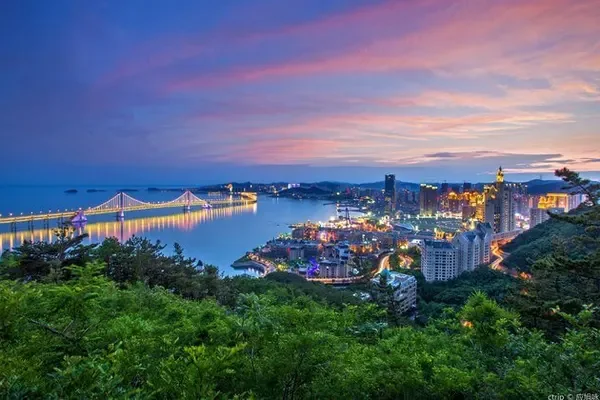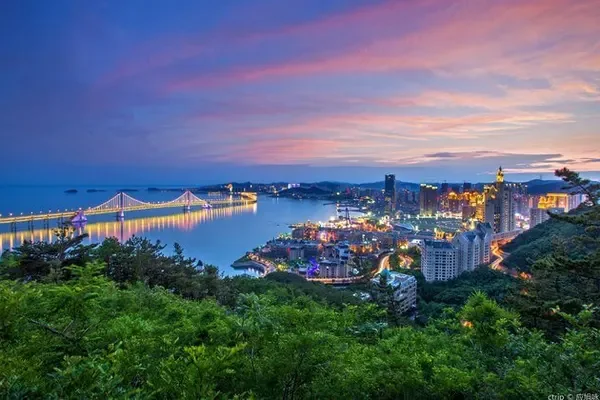
Ningxia Three-Day Tour (3) - Helan Mountain and Rock Paintings
Generally, the one-day tour of Yinchuan does not arrange Helan Mountain petroglyphs. Probably everyone thinks that there is something to see here, so there are few people who come here. But I think this place is worth seeing. The Helan Mountain alone is very spectacular, and the petroglyphs are even more precious.
In fact, if you stand in Pingchuan, west of Yinchuan, you can see the majestic Helan Mountain at a glance. It takes less than an hour to drive to the foot of Helan Mountain. If you have enough time, you can go to the Xiaogunzhongkou Scenic Area. According to the tour guide, it was a summer resort for emperors as early as the Western Xia Dynasty. The mouth is surrounded by mountains on three sides and opens to the east. The bell hammer and the rolling bell mouth got their name from this. There are Helan Temple, Bijia Peak, etc. in the mountains, and the scenery is very pleasant. This is also the origin of Helan Stone. It's a pity that we don't have time or strength, so we have to wait until we have time later.
Our purpose is to see rock paintings, so we went straight to Helankou, where the rock paintings are more concentrated. When the car arrives at Helankou, the first thing you see is the large plains at the foot of Helan Mountain, but here you can hardly see any crops or trees. There are large and small stones everywhere, some of which are several tons in size. Even hundreds of tons (I estimate), the small ones weigh a few kilograms, they were all impacted by flash floods from the Helan Mountains to the plains, and as far as the eye can see, they are all big rocks extending for several kilometers. Rarely, you have to believe that the forces of nature are so great that they can move such a huge stone for several kilometers. This place is very desolate. After a rain, the grass on the ground immediately revived, and it looked green, but the green was covered with white stones. As long as it doesn't rain, there is no green at all.
Entering the Helan Pass, you can see Helan Mountain up close. It is different from other mountains I have seen, as if it has just been cut with a knife. It's strange that the rocks are rugged, ups and downs, straight into the clouds. It is said that this is a fault zone that has been active more than a billion years ago, like the suture of the earth's wound. One-sixth of my country's major earthquakes occur here. Therefore, a famous seismic station was established on Helan Mountain to monitor the movement of the earth at all times.
Helan Mountain has undergone many crustal changes, from the ocean to the land, and from the land to the seabed. Its activities are frequent, sinking and floating, rising and falling. Until about 100 million years ago, Helan Mountain suddenly rose like a tall horse. The majestic steed was born out of the sky, lying between the Ningxia Plain and the Inner Mongolia grassland. It runs north-south and divides most of our country into two parts with obvious differences, east and west. Its rocks are red, brown, gray, and yellow in many colors, and many places are as smooth as a knife. If you look carefully, you can find the remains of ancient organisms. Strange peaks and rocks abound, some are like camels, some are like eagles, some are like whales..., look up and let your imagination run wild. The peaks here are almost all composed of rocks, and there are few soils, so the plants are also very rare, but you often see wild flowers and trees in the crevices of the rocks, and you will be amazed at the tenacious vitality of these plants. Why not? Only those who can adapt to the environment and have tenacious vitality can earn their own share in adversity.
Between the two mountains is a small valley with gurgling springs flowing down from the upper reaches of the ditch mouth. According to the tour guide, the spring water here is of good quality and is drinkable mineral water. Anyway, no one can be seen upstream, and the water will not be dirty. , I dared to taste it, it was really cool and sweet, but there are too many tourists, so I can't guarantee whether it will be clean or not.
Following the guidance of the tour guide, we began to see the famous rock paintings. The petroglyphs in our country have a long history and are precious pictures drawn or carved on rocks by ancient ancestors. Rock paintings in the south are mostly painted on stones with pigments (animal blood plus iron oxide powder), but rock paintings in the north are mostly made of stones, animal bones or metals ground, carved and chiseled on stones. It is a pity that for many years, no one has paid attention to the protection of cultural relics. When Europe exhibited their petroglyphs, we discarded so many petroglyphs with research value in the mountains, and let the local farmers use them as bases. The stone materials for the wall and kang were moved back to the home. It was not until 1987 that the government began to conduct a large-scale census and registration of rock paintings on Helan Mountain. There were more than 2,000 pieces registered in the register, and more than 20,000 individual patterns. Many of the things we saw at Yankou were big stones with precious petroglyphs recovered from farmers' homes.
There are more than 300 rock paintings in Helankou that we visited, which are distributed in the valley less than 1 kilometer, and they are quite concentrated. The rock paintings of Helan Mountain are by no means the works of one period or one nation, and they have lasted for 2,000 years. The earliest may be in the Spring and Autumn Period and the Warring States Period, more than 3,000 years ago. The late ones were in the Xixia, Yuan and Ming dynasties. This can also be seen from the chiseled tools, some are chiseled with stone tools, and some are chiseled with metal. Since ancient times, there have been many ethnic minorities in the Helan Mountains, such as: Huns, Xianbei, Turks, Dangxiang, Tubo, Mongolia, etc., who have nomadic and hunted here. These rock paintings are used by them to express their emotions and wishes, and to record their lives and aesthetics. picture.
We walked, watched and listened to the explanations. There are rock paintings of various animals. Although a tiger is incomplete, it is carved very clearly. The markings on the back are clearly visible. There are deer and double sheep here. Out of the circle, there are cows, monkeys, and some deer mothers with their young sons. The images are vivid and vivid, which fully reflects the nomadic people's familiarity and preference for animals. There are many human face paintings in the rock paintings here. Some of these people have a long antenna-like thing on their heads, which is said to be the image of a wizard. At that time, people believed that wizards were able to communicate with the gods. There is also a figure with arms bent, legs spread apart, and a long knife on the waist, which shows the image of a witch (shaman, reading seat) incarnated as a totem. This unique worship and admiration is rare in other rock paintings , and this image is very similar to the figure on the pottery unearthed in the Yangshao Culture, which is of great help to the study of the age of rock paintings.
Among the human faces in the rock paintings, some characters have feathers on their heads, and some have horns, which are very similar to the images of Indians. It is said that they are related to the great migration of prehistoric humans. Many paintings showing women are also very interesting, some with headdresses, some with hair buns, graceful and charming. The most famous one is the sun god. It is very clear on the high rock wall. It not only has big eyes, but also has a pair of arms, and it emits light all around. It is very similar to the sun in our mythology. It is a prehistoric The image of the sun in the minds of humans and nomadic peoples is humanized and engraved in this way to worship. You can also see pictures of people partying and dancing here. From these petroglyphs, we can almost understand all kinds of ancient worlds.
Handprints are also a feature of the rock paintings here. Handprints represent ownership, and engraving your own handprints next to many cattle and sheep indicates that these cattle and sheep already belong to you. What a rustic expression. The head of the goddess is also engraved on the rock. In one of them, the goddess opened one eye and closed the other eye, with a unique expression. This was used by the ancestors at that time to sacrifice to the gods. Here is the head of Saman, which is the image of an ancient wizard with a mask. There is a picture showing hunting, which actually uses the perspective principle of far small and near big. There is also a group of wars between two tribes, one side is victorious, so the sheep of one side are occupied by the other side, which is a kind of contractual picture.
The last piece of petroglyphs that the guide will take you to see is from the Xixia period. There are special hairstyles of Xixia people and Xixia characters. Although they are very old, nearly 1,000 years old, they are still very clear. Mount Helan, where rock paintings are so concentrated, has become a colorful art gallery for ancient nomads. Although these paintings are simple and childish, like the images drawn by children, they are rough and unrestrained. They paint what they see and express what they think. It can be described as uncanny, magnificent and spectacular. It's no wonder that many foreigners can't come out for a day once they get into the mountain pass.
Because we didn’t follow the big group, we were relatively free, so we didn’t go out with the tour guide here. (Generally, the tour guide only takes a small circle inside, and it’s over after seeing the main petroglyphs.) Walking along the valley, There are also many rock paintings, including children dancing holding hands, horses, deer, bows and arrows, etc., the images are lifelike and lifelike.
There is also a "water gate" in front of it. It is because of the water that humans live in it. Now a canal has been dug here to draw the water out. The more I go in, the more beautiful the scenery is. There are blue skies in the strange mountains on both sides. If I have time, I want to continue walking until I reach the source of the water.
Not far from Yankou, you can see the Twin Pagodas of Baisikou, which is also a national cultural relic protection unit. The pair of sister towers are located in a valley surrounded by mountains on three sides at the eastern foot of Helan Mountain. From a distance, there is almost no difference between the two towers. In fact, the east tower has 13 floors, and there are relief animal heads under the eaves of each floor. The west tower is slightly fuller than the east tower, with 14 floors, and above the second floor there are niches, in which there is a statue of Buddha, with brick beast heads containing rosary beads on both sides, and lotus petals carved at the corners of the eaves of the tower. They are all very precious.
I like playing very much. Over the years, I have traveled almost half of China, but due to busy work, I have never started to write. Looking back now, many things have been forgotten. That's why I made up my mind to record my travel experience and the scenery everywhere. Although I don't study literature and can't write, I think it is enough to truly record what I see and feel.



































